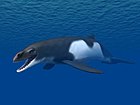Incakujira (meaning Inca whale) is a genus of rorqual whales that lived during the Late Miocene epoch in what are now the coasts of Peru, about 8 million to 7.3 million years ago. It contains two species, Incakujira anillodefuego and Incakujira fordycei. The type species, I. anillodefuego, was named and described in 2016. The second species was described in 2024. All known specimens have been found in the sediments of the Pisco Formation of Peru, which dates to the Late Miocene.
Description

Incakujira differs from other rorquals (fossil and extant) in having a less attenuated rostrum and the features of the maxilla, supraorbital, and remainder of the cranium. Kujira in the genus name means "whale" in Japanese.[1][2]
Paleobiology
The twisted postglenoid process of the squamosal suggests that the lunge-feeding capabilities of Incakujira were not as great as those of extant rorquals, and that Incakujira itself also pursued additional krill-feeding strategies like skimming.[1]
References
- ^ a b Marx, F. G.; Kohno, N. (2016). "A new Miocene baleen whale from the Peruvian desert". Royal Society Open Science. 3 (10): 1–27. Bibcode:2016RSOS....360542M. doi:10.1098/rsos.160542. PMC 5098998. PMID 27853573.
- ^ Kimura, T.; Hasegawa, Y. (2024). "A new species of Late Miocene balaenopterid, Incakujira fordycei, from Sacaco, Peru" (PDF). Bulletin of the Gunma Museum of Natural History (28): 1–14.
External links
 Media related to Incakujira at Wikimedia Commons
Media related to Incakujira at Wikimedia Commons Data related to Incakujira at Wikispecies
Data related to Incakujira at Wikispecies






Recent Comments